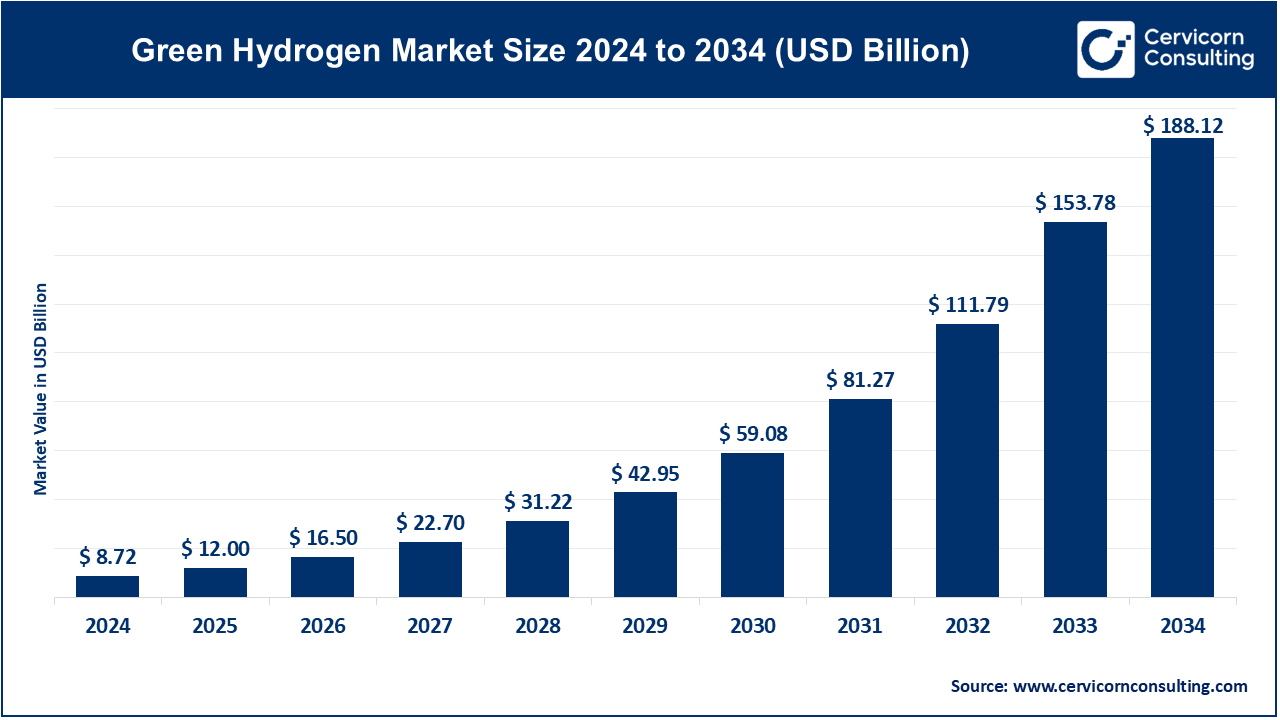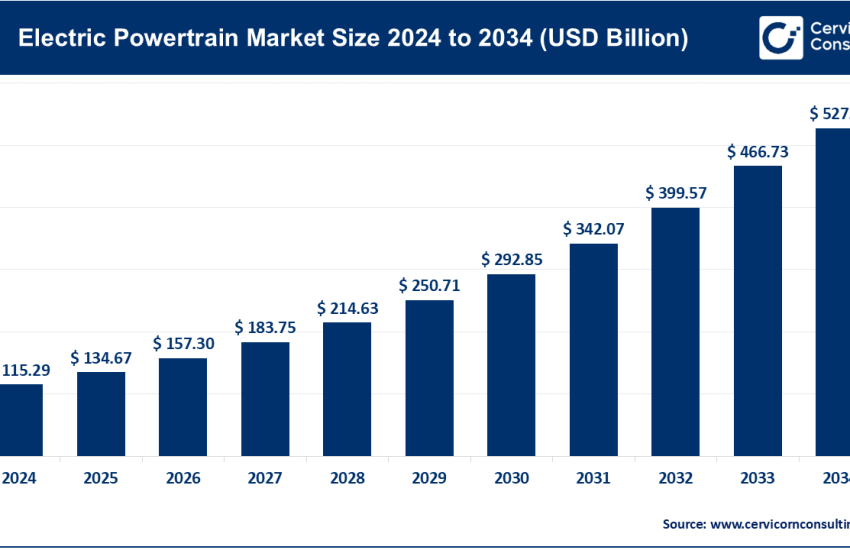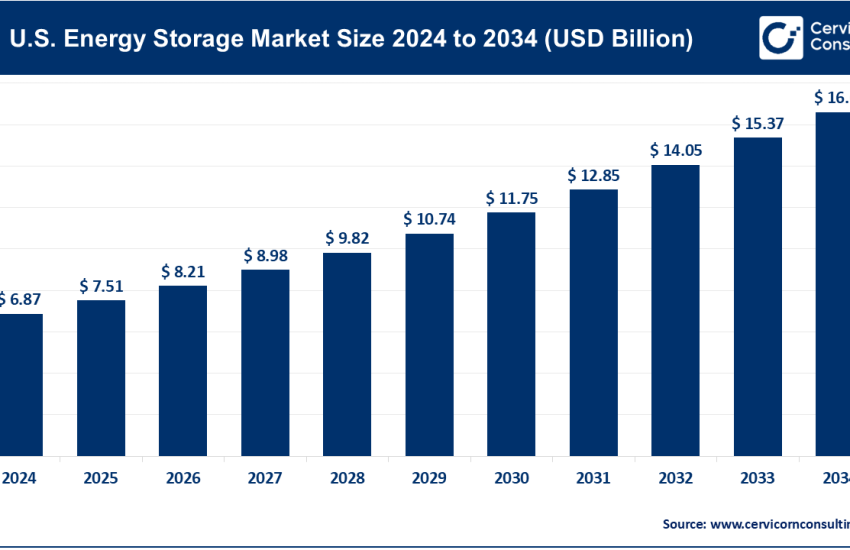Green Hydrogen Market Growth, Trends, Drivers, and Future Insights (2025-2034)
Green Hydrogen Market Growth
The global green hydrogen market was worth USD 8.72 billion in 2024 and is anticipated to expand to around USD 188.12 billion by 2034,, registering a compound annual growth rate (CAGR) of 35.95% between 2025 and 2034.
The growth of the green hydrogen market is driven by several factors, including global decarbonization goals, increasing investments in renewable energy infrastructure, technological advancements in electrolyzer efficiency, and supportive government policies and subsidies. Additionally, growing demand from industries such as ammonia production, steel manufacturing, and long-haul transportation has further catalyzed market expansion.
What is the Green Hydrogen Market?
The green hydrogen market refers to the production, distribution, and utilization of hydrogen generated through renewable energy sources such as wind, solar, and hydropower. Unlike grey hydrogen, which is derived from fossil fuels, green hydrogen is produced using an electrolyzer powered by renewable energy to split water into hydrogen and oxygen, ensuring zero carbon emissions during the process. This burgeoning market is a cornerstone of global efforts to transition to cleaner, sustainable energy systems.
Why is the Green Hydrogen Market Important?
Green hydrogen is a game-changer for global energy systems. Its ability to decarbonize hard-to-abate sectors such as heavy industry, transportation, and power generation positions it as a critical solution for achieving net-zero emission goals. Moreover, its versatility as an energy carrier and raw material opens avenues for reducing reliance on fossil fuels, enhancing energy security, and fostering innovation in clean technologies. Governments and industries worldwide are investing heavily in this market, recognizing its potential to revolutionize energy systems and combat climate change.
Get a Free Sample: https://www.cervicornconsulting.com/sample/2352
Top Companies in the Green Hydrogen Market
Here are some of the leading companies in the green hydrogen market, their specializations, key focus areas, notable features, 2023 revenue, market share, and global presence:
1. Air Liquide
- Specialization: Industrial gases and hydrogen solutions.
- Key Focus Areas: Renewable hydrogen production, hydrogen mobility, and large-scale electrolyzers.
- Notable Features: Leader in hydrogen refueling stations and partnerships with governments for clean energy initiatives.
- 2024 Revenue (Approx.): $26 billion.
- Market Share (Approx.): 15%.
- Global Presence: Strong presence in Europe, North America, and Asia-Pacific.
2. Linde plc
- Specialization: Industrial gas production, distribution, and applications.
- Key Focus Areas: Hydrogen liquefaction, storage, and transportation technologies.
- Notable Features: Pioneering large-scale green hydrogen plants and collaborations with renewable energy providers.
- 2024 Revenue (Approx.): $33 billion.
- Market Share (Approx.): 20%.
- Global Presence: Extensive footprint across Europe, the Americas, and Asia.
3. Hydrogenics Corporation (a subsidiary of Cummins Inc.)
- Specialization: Electrolyzer technology and fuel cell systems.
- Key Focus Areas: PEM electrolyzers, fuel cell modules, and hydrogen infrastructure.
- Notable Features: Advanced electrolyzer technology for grid-scale applications.
- 2024 Revenue (Approx.): $1 billion (Cummins overall revenue: $28 billion).
- Market Share (Approx.): 8%.
- Global Presence: Operations in North America, Europe, and Asia.
4. ITM Power
- Specialization: PEM electrolyzer technology.
- Key Focus Areas: On-site hydrogen generation, grid balancing, and decarbonization projects.
- Notable Features: Collaboration with Shell and other energy giants for green hydrogen stations.
- 2024 Revenue (Approx.): $50 million.
- Market Share (Approx.): 3%.
- Global Presence: Predominantly Europe and expanding globally.
5. Nel ASA
- Specialization: Electrolyzers and hydrogen fueling stations.
- Key Focus Areas: High-efficiency electrolyzer solutions and expanding hydrogen refueling infrastructure.
- Notable Features: Cutting-edge alkaline and PEM electrolyzers and strong focus on scaling production.
- 2024 Revenue (Approx.): $150 million.
- Market Share (Approx.): 5%.
- Global Presence: Active in Europe, North America, and Asia.
Leading Trends and Their Impact
- Scaling Up Production: The industry is witnessing a shift from pilot projects to large-scale green hydrogen plants. This trend reduces production costs and accelerates commercialization.
- Technological Innovations: Advancements in electrolyzer efficiency, modular designs, and renewable integration are driving down costs and enhancing scalability.
- Strategic Partnerships: Collaborations between governments, technology providers, and energy companies are fostering ecosystem development and accelerating deployment.
- Hydrogen Mobility: Adoption of hydrogen fuel cells in vehicles, particularly in heavy-duty transportation, is boosting demand and infrastructure development.
- Cross-sector Integration: Green hydrogen is being integrated into sectors like ammonia production, steel manufacturing, and power storage, diversifying its applications.
Successful Examples of Green Hydrogen Projects
1. HyDeploy (United Kingdom):
A pilot project blending green hydrogen with natural gas in the gas distribution network to reduce carbon emissions.
2. Hydrogen Valley (Netherlands):
A large-scale integrated green hydrogen ecosystem involving production, storage, and consumption across industrial and residential sectors.
3. NEOM Green Hydrogen Project (Saudi Arabia):
One of the world’s largest green hydrogen plants powered entirely by solar and wind energy.
4. Port of Rotterdam (Netherlands):
A major hub for green hydrogen import and distribution, facilitating decarbonization of European industries.
5. Japan’s Hydrogen Society:
Extensive adoption of green hydrogen in residential fuel cells and fuel cell vehicles, supported by robust government policies.
Regional Analysis: Government Initiatives and Policies Shaping the Market
1. North America:
- United States: Initiatives like the Hydrogen Energy Earthshot aim to reduce the cost of green hydrogen to $1/kg by 2030. Federal funding for green hydrogen hubs is bolstering regional growth.
- Canada: Strong focus on decarbonizing industrial sectors and transportation through green hydrogen strategies.
2. Europe:
- Germany: The National Hydrogen Strategy outlines a roadmap to position Germany as a global leader in green hydrogen, with significant investments in R&D and infrastructure.
- France: Plans to develop 6.5 GW of green hydrogen capacity by 2030, supported by a $7 billion investment.
- United Kingdom: Commitment to 5 GW of low-carbon hydrogen production by 2030, with significant subsidies and pilot projects.
3. Asia-Pacific:
- China: Aggressive investments in hydrogen fuel cells and production facilities, aiming to lead the global market.
- Japan: Pioneering hydrogen adoption in residential and mobility sectors, backed by government subsidies and a long-term vision for a hydrogen economy.
- Australia: Leveraging vast renewable energy resources to become a major green hydrogen exporter.
4. Middle East and Africa:
- Saudi Arabia: The NEOM project underscores the region’s ambition to become a global green hydrogen hub.
- South Africa: Government initiatives focus on harnessing renewable energy potential to develop green hydrogen infrastructure.
5. Latin America:
- Chile: Leading the region with plans to become a top green hydrogen exporter, supported by abundant solar and wind resources.
- Brazil: Strong emphasis on green hydrogen to decarbonize industrial processes and leverage renewable energy potential.
To Get Detailed Overview, Contact Us: https://www.cervicornconsulting.com/contact-us
Read Report: Hydrogen Generation Market Trends, Growth Drivers, and Regional Insights (2023-2033)



